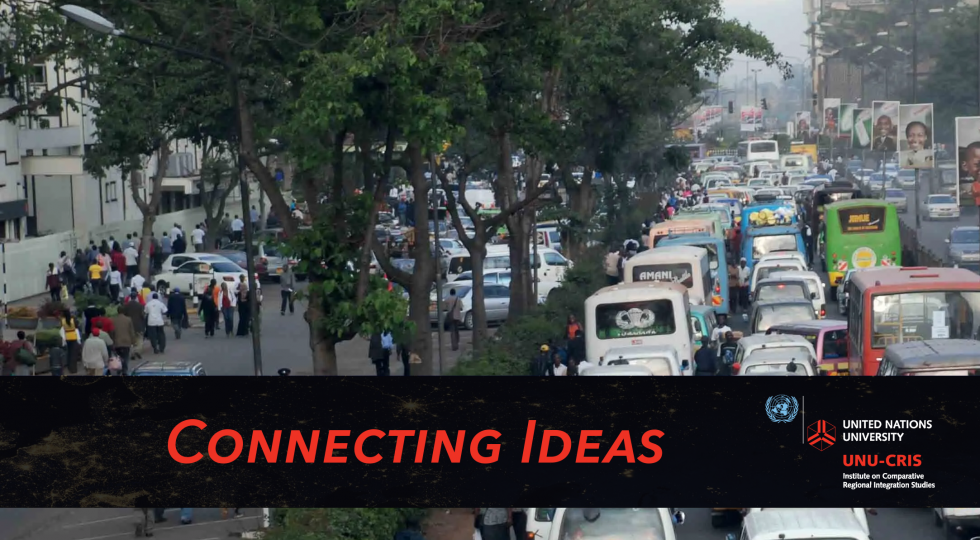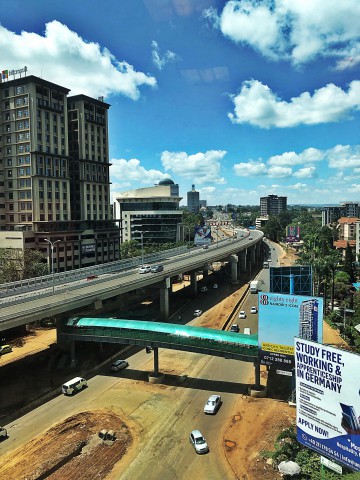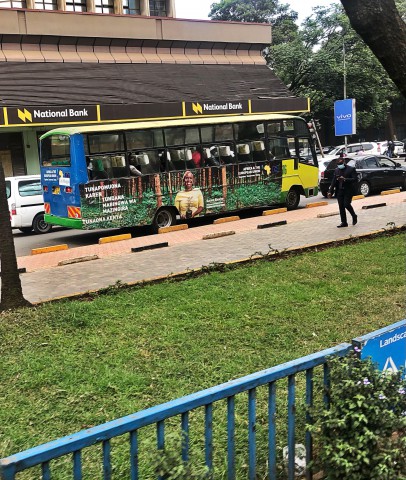Taking The High Road: A Journey Towards Improved Mobility In East Africa


Policy analyst and graduate of the MSc Public Policy and Human Development, Maastricht University/UNU-MERIT
30 January 2023 | #23.01 | Author wishes to thank Issa Baluch for his valuable input and contributions to this article. The views expressed in this post are those of the authors and may not reflect those of UNU-CRIS.
“When they go low, we go high”
This simple mantra uttered by Former First Lady of the United States, Michelle Obama, stems from the expression ‘To take the high road’ which means to choose to behave morally when provoked otherwise. In certain parts of the world, the high road also means the fastest route home. In Nairobi, Kenya, this could be said of the Expressway, a toll road that rises above the traditional highway, and due to less traffic prevalence, offers a faster route to one’s destination.

Inset: image of the Nairobi Expressway, Nairobi Kenya (Image by author)
Since 2012, the East African region has seen rapid improvements in road transport and intraregional mobility, including the construction of 13 One Stop Border Posts (OSBPs) to facilitate clearance of persons and freight; expansion and rehabilitation of key transport routes such as the Northern corridor and introduction of Bus Rapid Transit (BRT) systems in various forms across different cities. After the resumption of movement in the aftermath of the covid, urban planners have a responsibility to examine how the world and, consequently, the transport preferences have changed. While there is not a lof of studies on behavior changes since the outbreak of Covid-19, a look at pre-pandemic mobility and initiatives to enhance Non-Motorized Transport (NMT) is a good start to identifying new trends and missed opportunities in mobility. A cross-regional perspective is necessary for a broader understanding.
The average commute in different regions
According to the latest EU-wide survey of commute time, more than half (61.3%) of employed people in the EU travel less than 30 minutes from home to work=. The survey which was conducted in 2019 presented pre-pandemic data. In the same year, the average commute in the United States took 27.6 minutes, while in Great Britain the average across all modes of transport was 31 minutes, eventually dropping to 28 minutes in 2020. More recently in 2021, the average commute in the top seven cities in China is reported to have been over 40 minutes. Estimations of the average commute times in Africa vary and widescale studies are far apart. In Kenya, the average commute was 30 minutes in 2013, according to a World Bank study. More recent data is scarce. Today, with access to the Internet, one can predict their time of travel from one location to another (through Google/Apple Maps and other software). This has not always been the case. A 1981 publication on techniques for estimating the average duration of commuter trips provides the following options for estimating traffic flow:
- Sourcing data for the speed of traffic flow at different locations from local traffic authorities.
- Travelling outward from the city center along a radial road and recording the cumulative travel time at various distances (and thereafter using the data as an estimate)
While the age of the Internet has provided useful options for estimating travel time, in cases where one plies the same route every day, routine sets in and they may not be prone to consulting software. Moreover, traffic data is not necessarily useful in some cases, for example when one is walking. With the increasing popularity of Non-Motorized Transport, following concerns surrounding climate change, as well as the need for healthier lifestyles, walking could evolve from an inevitability for some, to a preferred mode of transport. According to the World Economic Forum, the primary mode of transportation for more than 45% of urban residents in Nairobi (Kenya) and Kampala (Uganda) is walking. These two capital cities have in recent years benefitted from projects to enhance non-motorized mobility of persons.

Left – Namirembe Road, Kampala Uganda. ALT description: a person walking, motorcycle ferrying two passengers and the driver, tuktuk and bus emerging from side road.
Right – Luwum Street, Kampala Uganda. ALT description: bicycle station
(Images by author)
Investment in Non Motorised Transport
In Kampala city, authorities have collaborated with partners to establish cycling lanes, ride share, and car-free zones. The project which saw significant impetus in 2018 has had mixed levels of success since, with vehicles encroaching on cycling paths in some areas, and people walking in bicycle-designated areas. Regardless, the existence of the infrastructure is indicative of policy choices that seek to encourage and facilitate better mobility for persons using non-motorized options. In Nairobi city, steps have also been taken to enhance the walkways in the city centre.

Inset- a walkway on Kenyatta Avenue, Nairobi Kenya (Image by author)
While these solutions may not always achieve maximum results, they provide a baseline for the implementation of other projects to enhance mobility, particularly in congested areas.
In Kigali city, various efforts have been made to enhance mobility including ride share, a cashless bus system, and designated car-free areas. One can purchase a ‘Tap&Go’ card from certain bus parks, and load amounts as low as $1 for a two-way trip of 5 kilometers. The use of motos (motorcycles) remains popular.
Rideshare in Kigali city, Rwanda (Image by author)
Designated walkway and cycling path in Nyandungu EcoPark, Kigali Rwanda (Image by author)
Despite relative success in easing the safety of non-motorised travellers, these systems are not impervious to mismanagement across the different nations. Encroachment of walkways by motorists, weak public uptake of rideshare, and inadequate reach of such systems in preurban areas are just but some challenges. In addition, distance from workplaces decreases the likelihood of an individual utilising non-motorised transport.
Beyond limits:a new age for intraregional mobility
On a broader scale, while efforts to enhance local transport continue to be implemented, intraregional mobility is still insufficient. The time taken for travel between Nairobi, Kenya, and Kigali, Rwanda by road averages 22 hours (including border clearance), whereas by air the same journey takes an hour (including airport clearance). A train could provide a cheaper alternative to a plane if such a train existed between the two capitals. A multilevel governance approach that paves way for collaboration in infrastructure plans and implementation could provide necessary networks for intraregional transport initiatives. Such an approach would require expertise and the willingness to invest capital at a regional scale with coordinated implementation at the local level. Indeed as the region continues to implement the EAC development strategy, and other regional plans, interoperability will be determined by the interaction between states and their willingness to invest in targeted infrastructure in a coordinated manner.
As we continue to learn from the effects of the pandemic, what was true in 2010 when Transport Logistics was first published, remains true today “In an environment of variability, only those who are aware of changes and willing to adapt to changes will survive.” One such pioneer that is changing the game in the mobility sector is EVFLY. Capitalising on the triple goal of making transport cheaper, more flexible, and environmentally friendly, while cutting out the need for fuel, EVFLY is poised to bring much-needed speed to intraregional travel, at a fraction of the current costs. In the near future, the company will begin operations in Africaalready , started in South East Asia. Using innovative electric vertical take-off and landing (eVTOL) aircraft, eliminating the need for traditional airplane runways as we’ve known themseems more than reachable for regional transport.. What was once a dream could become a reality for not only freight but also passenger travel. Indeed, the sky has not been the limit for a long time.
